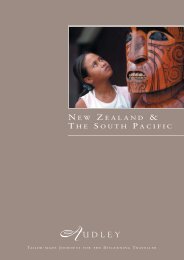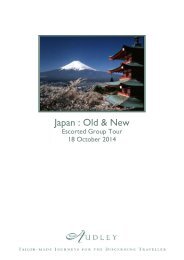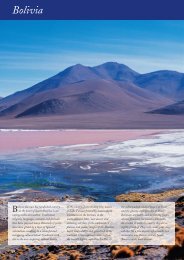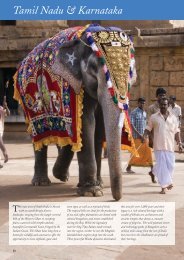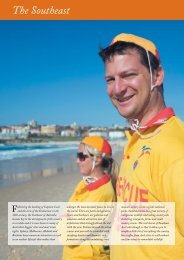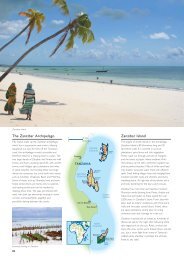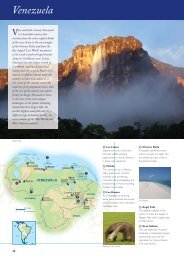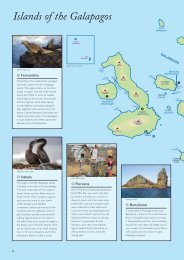Download - Audley Travel
Download - Audley Travel
Download - Audley Travel
You also want an ePaper? Increase the reach of your titles
YUMPU automatically turns print PDFs into web optimized ePapers that Google loves.
Experience North Africa<br />
and the Middle East<br />
With Arabic spoken across most of the region it is easy to think of the countries in<br />
North Africa and the Middle East as being homogeneous and indistinct. This is far<br />
from the case though, and each has its own unique customs, traditions, and history to be<br />
discovered and experienced.<br />
Ancient sites<br />
Byzantine mosaic, Lebanon<br />
Carpets in Kairouan, Tunisia<br />
Nasir al Mulk Mosque, Iran<br />
From Voloubilis in Morocco to Persepolis in Iran,<br />
the region’s archaeology and architecture<br />
demonstrate the historical and cultural influences<br />
which have come and gone through the millennia<br />
across the region. Egypt has perhaps the richest<br />
collection of ancient monuments, spread<br />
throughout the country and with plenty still to<br />
be discovered. The Pyramids of Giza are without<br />
doubt one of the most recognisable structures in<br />
the world, and exploring the Nile Valley will bring<br />
you to one of the largest religious buildings in the<br />
region, the Temple of Karnak. Archaeological sites<br />
in Lebanon and Syria originate from a medley of<br />
different periods of antiquity, with places such as<br />
Byblos claiming a history of over eight millennia.<br />
In Tunisia, evidence of the Carthaginians was<br />
almost entirely swept from the map with only<br />
tiny vestiges of their civilisation still visible today,<br />
at Kerkouane and the Punic Ports.<br />
The cradle of civilisation<br />
What strikes most visitors to this area is just how<br />
ancient the sites and monuments littered across<br />
the region are. The Pyramids of Giza, for instance,<br />
were more ancient to Jesus than Jesus is to us<br />
now. As far back as the fifth millennium BC, the<br />
Sumerians were developing sophisticated social<br />
structures and around 1400 BC, the Phoenicians<br />
created the first alphabet in their original lands in<br />
the Levant. The Great Pyramid in Egypt was<br />
completed around 2600 BC and Ancient Egyptian<br />
culture flourished for thousands of years before<br />
being absorbed into the Classical World. The<br />
Greeks and the Romans in their turn dominated<br />
the region, leaving behind their trademark<br />
colonnaded streets, temples and theatres. Against<br />
this backdrop, the Jewish and Christian faiths<br />
came into being, followed in the 7th century AD<br />
by Islam, spreading outwards from the Arabian<br />
peninsula with the Arab Conquest. The countries<br />
of the region are thus home to some of the most<br />
important religious monuments in the world,<br />
including the earliest temples, churches, mosques<br />
and the tombs of the prophets.<br />
Local ladies, Egypt<br />
Local culture and etiquette<br />
A degree of cultural sensitivity is required when<br />
visiting the countries in this brochure. Religion is<br />
an important aspect of life for most of the people<br />
you will meet – Islam is the predominant faith,<br />
but Christianity and Judaism are also present,<br />
along with small sects such as the Druze in Syria<br />
and Lebanon. The level of conservatism varies<br />
from country to country, and some have had<br />
greater exposure to European visitors than<br />
others, so the degree of moderation you need<br />
to display does vary. Our specialists will advise<br />
you on this.<br />
However, there are some general rules that you<br />
should always respect. Women should not wear<br />
tight or revealing clothing, and it is always<br />
advisable to keep the shoulders and upper arms<br />
covered, as well as wearing shorts or skirts and<br />
dresses that reach at least to the knee. Men<br />
should always wear a shirt or t-shirt; in some<br />
places shorts are acceptable, in others trousers<br />
are a better option. Where it is possible to visit<br />
a religious building, such as a mosque or a<br />
church, always cover the shoulders, arms and legs.<br />
In mosques you will normally also be required to<br />
take off your shoes and women may be required<br />
to cover their heads. Ramadan, the month of<br />
fasting in Islam, is a time when things slow down<br />
a bit during the day and opening hours are<br />
curtailed, although it is perfectly possible to travel<br />
in some countries at this time.<br />
4



